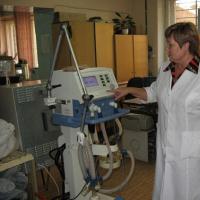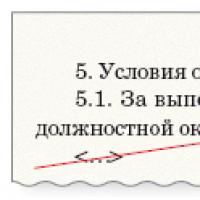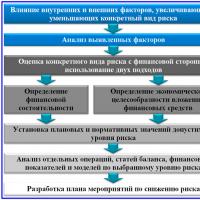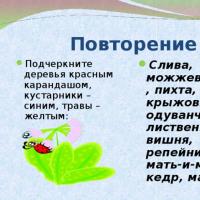Summary of a lesson on decorative drawing “Gorodets patterns” in the preparatory group. Summary of GCD in the senior group. Decorative drawing Plan outline for decorative drawing
MBDOU "Kindergarten No. 141 "Pilesh" Cheboksary
“Painting a board based on Gorodets painting”
Performed:
teacher Ellina E.A.
Cheboksary, 2018
Lesson notes on decorative drawing
in the preparatory group “Painting boards based on Gorodets painting”
Software tasks:
Educational: 1. Continue to introduce the history of the Gorodets painting industry.
2.continue to introduce Gorodets painting, its color, the main elements of the pattern,
3. To develop children’s ability to independently come up with a pattern based on Gorodets painting, placing it on a sheet of paper.
4. Strengthen children’s ability to draw straight and rounded plant garlands in compliance with the characteristic color combinations of Gorodets painting.
5. Strengthen the ability to draw with the whole brush and its end.
Educational: 1.Develop a sense of composition.
2.Develop children's creativity.
Educational: 1. To cultivate love and interest in folk crafts, aesthetic perception.
2. cultivate friendly qualities, a friendly attitude of children towards each other, a desire to help.
Material: gouache, wide and narrow brushes, (squirrel No. 1, 2, 3) napkins, glasses of water, Gorodets boards, a simple pencil, palette, eraser, letter from Tube.
1. Organizational moment.
Educator: Guys, today to our address kindergarten a letter arrived from Tubik, a friend of Dunno. Guys, I suggest you read it. (Dear guys, please tell me about Gorodets painting and its features. Help me decorate the board with the Gorodets pattern. Sincerely, Tube.)
Educator: Guys, let's tell Tube about Gorodets painting?
To begin with, I would like to ask you a riddle.
In blue swimsuits,
In red buds,
Large and small
In green leaves
They brought a casket
from the city... (Gorodets).
Children's answers.
Educator: I I want to introduce you to the legend of Gorodets painting.
Each Russian craft has its own legend. There is such a legend about the Gorodets fishery. The village of Gorodets is very beautiful. The banks here are high, gully, all the villages are on it. The huts in the villages are nice, tall, with large windows and rich carvings, cheerfully painted, and almost every resident remembers how they once celebrated Midsummer’s Day here. It was such a holiday. In some areas it was called Ivan Kupala, in others – Ivan the Travnik, but everywhere it was celebrated on the night of June 23-24. During these days, the rapid growth of grasses ends, the ripening of cereals begins, and the superstitious person believed that it was here that evil spirits were trying to cause the greatest harm, to destroy the harvest. On this short clear night, people lit high fires, jumped over the fire, began to have fun, sometimes told fortunes, floated wreaths along the river - to which bridge the betrothed will float, from there.
And everyone strove to pick useful herbs that night. Indeed, the best juices are collected in plants during this period. They went after a mysterious fern flower, which blooms, they say, only on this one night, not even a night, but just an hour that separates one dawn from another. What kind of flower is that? Nobody knows: some claim that it is fiery yellow, glowing like tongues of flame in a fire; others said that the ivy was scarlet, like a coal, and still others said that it glowed, but not yellow, not scarlet, but seemingly blue-blue. So understand here. But everyone said that he was of extraordinary beauty. It seems quite simple, but better than all the flowers in the world. Because a fern flower is a flower of happiness.
Here in these Nizhny Novgorod villages, near the city of Gorodets, the ancient craft..
Gorodets craftsmen painted homes, shutters, doors, gates, household items, children's furniture, and toys. Gorodets masters brightly paint objects. On big things, these are usually scenes from the city and rural life. And between the pictures are flowers of unprecedented shape. And they began to call them roses, kupavkas, but they don’t look like roses. The Russian master wanted to keep an extraordinary flower-flower happiness.
Educator: guys, we are already a little familiar with Gorodets painting. I suggest you turn into real masters of Gorodets patterns. First, let's remember what elements Gorodets patterns consist of and how they are arranged in the garland. To do this, I will ask riddles.
1) as if a miracle is blooming here and there (rosan)
2) she is round, like a cup, and her name is (daisy)
3) she won’t feel hot in the heat. She's in the water, she's (swimming)
4) It is not noticeable all year round - unopened (bud)
Educator: Tell me what else is painted in Gorodets painting, besides flower garlands.
Children's answers.
Educator: t Now think about what makes Gorodets patterns (Ozhivki) elegant.
How will you paint the animations? (With the tip of the brush)
And how will you draw the arc? (We start with the end of the brush, then press the brush, drawing with all the bristles and finish with the end of the brush)
Now tell me, what color combinations will we use to draw the Gorodets garland? (pink with red, blue with blue)
And for the animations, what colors will you use? (White black)
Educator: Now let's rest, stretch our arms and legs.
One - bend over, straighten up
Two - bend down, stretch,
Three-three claps in the palm,
Three nods of the head,
Four hands wider
Five, six - sit down quietly,
Seven, eight - let's discard laziness.
Educator: Before we start painting the boards, I suggest you remember how to mix paints to get shades of blue and red (children's answers)
Clarify by asking children the sequence of work.
Independent activities of children. During the work, the teacher advises the children, while the paint dries on the large circles of the bud, to depict leaves, and then draw “eyes and arms.” Finished works are exhibited at an exhibition where they themselves evaluate and choose best works. They express their opinion on why they liked this particular work.
Educator: Tell me, children, what did we do today?
Were you interested?
What happened?
What was difficult to do?
Educator: You all did a great job and helped Tube decorate the boards. He will be very grateful to you. Today you tried yourself in the role of masters of decorative applied arts. You painted boards based on Gorodets painting. Well done! They did a very good job. And, in my opinion, you did a wonderful job!
Drawing helps to open up creativity a child, helps to feel beauty, activates the development of fine motor skills, logical and abstract thinking, imagination and fantasy, sensory perception of the objective world. It is important to stimulate the natural curiosity and cognitive activity of older preschoolers with exciting tasks creative nature. The topic will help expand knowledge about folk arts and crafts, acquire the ability to draw patterns to decorate objects using various decorative elements (stripes, geometric shapes, dots), and improve the skills of choosing the most harmonious color combination.
Tasks, techniques and features of decorative drawing in the preparatory group
Decorative drawing - creating abstract rhythmic patterns and compositions to decorate objects. Drawing ornaments has a beneficial effect on the development of creativity, fine motor skills, imagination and fantasy, abstract and spatial thinking, sensory perception and the child’s intellectual abilities for synthesis and analysis.
Tasks
- develop a sense of color, learn to find an interesting and harmonious combination of colors;
- consolidate the ability to draw according to a model, teach drawing patterns based on a free design;
- improve technical skills in using a pencil and brush:
- draw dots, curls, wavy, straight, rounded lines with the tip and entire surface of the brush;
- freely change the direction of brush movement;
- be able to adjust the paint set and mix different colors to obtain the desired shade
- develop the ability to create a decorative pattern using straight and intersecting lines, as well as a rhythmic combination of dots, strokes, geometric shapes, floral patterns, and other elements of decorative painting;
- develop free, smooth hand movement and visual control;
- continue to get acquainted with folk ornaments, develop skills in designing flat and three-dimensional forms in the style of traditional painting.
Techniques
- A line - straight, broken, wavy, twisted into a spiral, can be of different lengths, thickness and rhythm and helps create the basis for the pattern and draw decorative elements.
- Hatching with colored pencils - simple but expressive and effective method conveying a rhythmic image of a floral or geometric ornament. In addition, drawing with strokes helps develop fine motor skills, which is very important for solving the problem of preparing the hand for writing.
- Shading - helps to achieve different degrees of color saturation depending on the degree of pressure of the pencil. It should be explained to children that drawing the pattern grid and decorative elements requires more pressure than painting the background.
- A point with the tip of the brush, a rhythmic stroke, brushing the entire surface with the brush.
Peculiarities
Children's decorative painting works (photo gallery)
Subject composition in the style of the Dymkovo tradition. Design of the product with floral ornaments (rowan branch)  Golden Khokhloma Painting with decorative elements (berries, curls, stripes, dots) Painting with floral patterns (strawberries, grass, leaves) Fiery colors of Khokhloma (berries, curls, grass) Drawing curls and grass on a tall product Decorative painting floral ornament
Golden Khokhloma Painting with decorative elements (berries, curls, stripes, dots) Painting with floral patterns (strawberries, grass, leaves) Fiery colors of Khokhloma (berries, curls, grass) Drawing curls and grass on a tall product Decorative painting floral ornament
Lesson notes on decorative drawing
In the preparatory group the standard long-term planning One drawing lesson per week is provided. The total duration of continuous activity should not exceed 20–25 minutes, methodological manuals It is recommended to conduct physical exercises (finger, breathing, motor exercises) for 5 minutes for relaxation and prevention of mental and physical fatigue in children.
Lesson outline:
- Organizational part (3–5 minutes). The practical part of the lesson can be preceded not only by reading fairy tales, poems or riddles, but also by watching educational pictures, presentations, a fragment of an educational film or cartoon. The information and familiarization stage involves awakening children's interest in the task and becoming familiar with the elements of painting for decorating objects. It is necessary to include surprise moments, elements of theatrical or didactic games that stimulate creative activity and create a psychologically comfortable environment.
- Practical part - the teacher explains the essence of the task (3–5 minutes). Older preschoolers are given more freedom in the drawing process; showing a sample prepared by the teacher is used less and less for sketching, more often to demonstrate new techniques or clarify the sequence of work. Techniques that have already been mastered do not require additional demonstration.
- Independent work of children (15–20 minutes). The teacher prompts and helps if children have difficulties or misunderstandings while drawing.
- The final part is the analysis and assessment by children of their works and the drawings of their comrades. Children are taught to formulate their point of view and verbally express aesthetic perception. creative works(3-5 minutes).
Lesson summary on the topic “Blue Gzhel” (author E. Ulimova)
| Goal of the work: introducing older preschoolers to the basics of arts and crafts Equipment: Items of decorative and applied art ( Zhostovo trays, Palekh boxes, Filimonov whistles, Khokhloma dishes, nesting dolls (Semyonov, etc.), an exhibition of Gzhel dishes and dolls in “Gzhel” costumes (At the beginning of the lesson, she is covered with blue and white chiffon), Cut-out pictures for the didactic game “Assemble the picture and guess painting”, Drawing of Gzhel dishes, painted over with white paint so that blue patterns, contour blanks of Gzhel ware, blue gouache, brushes No. 1 and 2. |
Samples and descriptions of work procedures
Gorodets painting - Russian folk craft, which appeared in the middle of the 19th century in the area of the city of Gorodets, is distinguished by its laconic forms (floral patterns, figurines of horses, birds, plot scenes), executed with a free stroke.
Presentation on the topic “Gorodets painting” (photo gallery)
A poem dedicated to the art of Gorodets painting. Description of the features of the Gorodets craft. Stages of completing the work. B color scheme bright pink and bright yellow colors predominate; decorative elements (chamomile, leaves, kupavka, rose, striped ornament) Location of the village of Gzhel Flower painting “horse” and “bird” motifs Subject painting Stages of drawing a bird
Video: How to draw the Kupavka flower - shading, shading and 3 types of shading
“In Gorodets’s workshop” - drawing the main elements of the painting (chamomile, bud, rose)
Instructions:

“Gorodets painting” - decorating a cutting board
Materials: cutting board blanks cut from paper, watercolor and gouache paints, medium and fine brushes.
Instructions:
- Using a simple pencil, draw a sketch of the pattern onto a paper board.
- Using a medium brush, paint over the background of the workpiece with watercolor paints.
- Using a thin brush, paint the underpainting for the chamomile.
- Similarly, using a different color, paint over the underpainting for the bud.
- Use gouache to draw the shadow of the kupavka and chamomile.
- “Live” the drawing of flowers with white gouache.
- Draw leaves, draw small decorative elements (curls, twigs, berries).
- Finished works.
“Fairytale Bird” - Gorodets painting
Materials: wooden cutting board or tinted paper blank, gouache, brushes of different sizes.
Instructions:
- Draw flowers at the top and bottom of the blank.
- Using light movements, apply thin curved contour lines of the back, chest and tail. Hold the brush vertically in relation to the surface.
- Paint over the body and tail, and use the tip of a thin brush to draw the beak and legs.
- Draw the paws with thin arched lines and draw the claws with three dots.
- Draw a wing in the shape of a leaf, and decorate the crest with pointed teeth.
- Use strokes to depict the plumage.
- Decorate the body and wing with patterns of dots, stripes, and strokes.
- Decorate the edges of the product with edging.
- Children's works.
“Black Horse” - traditional Gorodets folk painting
Drawing stages:

Video: educational film “Golden Khokhlima”
“Golden Khokhloma” - painting a paper blank in the shape of a cup with a herbal pattern with a photo
The herbal pattern is applied without creating a preliminary pencil drawing. Features of applying decorative elements:
- “sedge” - with the tip of the brush from top to bottom;
- “blades of grass” - drawn smoothly with thickening;
- “droplets” - using the dipping technique;
- “antennae” - a line twisted into a spiral;
- “bush” is a combination of symmetrically located “sedges”.
Children paint blanks cut out of paper.
Exhibition of children's works.
“Painting a plate based on Khokhloma painting” - drawing with wax crayons and watercolors
Instructions:
- Using yellow wax crayon, draw three leaves at the bottom of the plate.
- Use red wax chalk to draw strawberries.
- Draw droplet leaves.
- Draw curls between the leaves.
- Add small flowers and swirls to the top of the plate.
- Tint the entire plate with black watercolor.
“Bowl” - a craft made from salt dough
Instructions:
- Gently apply the dough from the center of the inside of the mold to the edges and distribute evenly over the surface.
- Wait until dry and remove from the mold.
- Using a thick brush, paint the background yellow, leaving the strip along the edge unpainted.
- Using a medium-sized brush, paint the edge of the bowl red.
- Using a thin brush, draw a curl that alternates up and down.
- Draw strawberries at the ends of the curls.
- Write down the green leaves.
- Use a thin brush to create a herbal pattern - rhythmic strokes with a slight thickening.
- Use yellow to make it “live” in the form of veins on the leaves and dots on the berries.
“Zhostovo bouquet” - painting trays
Materials: blank paper tray made of black paper, gouache, brushes.
Stages of work:
- Priming - apply silhouettes of flowers in the center of the workpiece.
- Shading - to give volume to flowers by drawing shadows.
- Highlight - use white gouache to draw thin lines on flowers and leaves.
- Drawing - use a thin brush to draw the veins on the leaves and the edges of the image.
- Finished works.
Video: Gzhel painting
Basic elements: mesh, droplet, brushstroke with shadow, decorative borders.
"Snowmen using the Gzhel technique"
The pattern is based on a mixture of white and blue colors, this allows you to get a wide range of shades from rich blue to dazzling white. Contrasting color transitions and smooth ones are allowed, which are obtained through shading.
Children work based on a model.
It is necessary to draw the silhouette of a snowman, decorate it with petals with a shadow, and finish drawing a staff with a spiral end and curls.
“Jug using the Gzhel technique” - a drawing using a combined technique (watercolor and felt-tip pen)
Instructions:
- Trace the cardboard blank with a simple pencil and complete the lines of the main part of the jug.
- Decorate the bottom and lid with a mesh, draw floral and geometric patterns on the handle and spout.
- Draw the lower contour of the body - a wavy line (beak, neck, tummy).
- Add another line going from the beak upward (head and neck).
- Draw the crest, beak and paws.
- Add two ovals (wings) and a tail.
- Decorate the wings with mesh and draw feathers.
- Draw a flower above the bird.
- Children's works.
“Gzhel Teremok” - drawing with a felt-tip pen followed by blurring
Instructions:
- Draw a ground line, then a main rectangle, and a low rectangle above it.
- Draw a house inside the main rectangle.
- Add triangular and dome-shaped roofs to the tower.
- Draw a balustrade pattern, draw horizontal lines of logs, decorate the roof. Add a hillock line and a hut on it.
- Draw a roof with a pipe, trees and clouds.
- Blur the drawing with a wet brush.
Children's works (photo gallery)
Drawing made with felt-tip pens Drawing made with felt-tip pens Drawing made with felt-tip pens Drawing made with felt-tip pens Drawing made with felt-tip pens
“Polkhov-Maidan” painting of a nesting doll
Instructions:
- Prepare blanks of paper nesting dolls with drawn oval contours of the apron and face.
- Draw a flower with a simple pencil.
- Finish drawing the berries.
- Use strokes to paint over the outline image of the flower with gouache.
- Draw leaves in green.
- Draw the face (nose, mouth, eyes and cheeks), paint over the scarf, cape and lower part of the figure.
- Children working on painting a matryoshka doll.
For fine art activities
Lesson notes on decorative
drawing for older children
Subject: “Decorative painting based on Gorodets painting”
Software tasks: continue to introduce children to Gorodets painting - its history, color, and constituent elements. Strengthen the ability to paint and place a pattern on a product. Improve techniques for toning paper, mixing paints, and brush skills. Develop a sense of rhythm and composition. To form an aesthetic attitude towards folk art.
Progress of the lesson.
The teacher invites children to the group:
Please come here soon.
Come in, honest people!
Have fun, don't yawn,
The fair is calling you all!
Fair! Fair!
Russian fair!
Who will come to the fair?
Whatever he wants, he will find everything!
Hey, good fellows and beautiful girls! Buy a Dymkovo spoon from a peddler. Well, if you don’t want a spoon, at least buy a Gorodets nesting doll.
Children: No! We came for Gorodets dishes.
Teacher-peddler: Well, I have a lot of dishes. Choose! (Offers children dishes of any type, but not Gorodets. Children do not take)
Teacher-peddler: Explain then what kind of dishes this is and how it differs from all the rest that I have.
Children explain the signs of Gorodets painting and name its elements.
Teacher-peddler: I have a lot of dishes, but I don’t have anything this outlandish. Can you help me get it?
Educator: Guys, let's help the peddler and paint the dishes with Gorodets painting. Choose whatever you want. (Children choose pre-prepared blanks, sit down and draw. The song “Fair” plays
Teacher-peddler: Oh, what wonderful dishes you have made. You are real masters! It’s not for nothing that they say: “Like the master, so is the work!”
But people go to the fair not only to look at people and show themselves off, but also to buy something for themselves. Let's try to sell our dishes. And to do this, you need to praise your product so that guests want to buy it.
Children praise their work and “sell” it.
Summary of the organized educational activities V senior group for decorative drawing.
Subject: "Merry Haze"
Integration educational areas: “Artistic and aesthetic development”, “Cognition”, “Physical development”.
Types of children's activities: productive, educational, research, playful.
1. Target: teach childrenpaint templates of Dymkovo toys.
Tasks:
Educational: continue to introduce children to Dymkovo toys, expand knowledge about the history and technique of their creation;
Developmental: develop hand motor skills; invite children to decorate pre-prepared figures from salt dough based on Dymkovo painting, choosing colors when making a pattern;
Educational: cultivate perseverance, the ability to complete work begun, interest in learning folk craft
2. Equipment and materials: sample of Dymkovo toys, paper silhouettes, posters depicting elements of Dymkovo painting, gouache paints, brushes, napkins, cups of water, figures of Dymkovo toys, media resources (presentation, Russian folk music).
3. Methods and techniques :
1) Game situation, using artistic words.
2) Demonstration and explanation by the teacher.
3) Observing the work of children.
4) Analysis of work by the teacher and children.
Preliminary work:
Conversation on the topic: “Dymkovo toy”, drawing Dymkovo patterns, looking at illustrations, toys with Dymkovo painting, making figures of ladies from salt dough, learning poems about the Dymkovo toy, making a Dymkovo lady costume, preparing a presentation.
Content of organized educational activities.
I Introductory part.
1. Organizational moment.
Communication game greeting.
"Hello friend, hello friend,
Get in a circle quickly.
Let's hold hands together
And let’s smile at each other.”
2. Introduction of the game moment.
Educator:
- Hello guys! Look at our small museum of Dymkovo toys, would you like to make it more diverse, more beautiful, brighter? I want to offer you a trip to the city of masters, and which one, you can guess for yourself by listening to the poem:
The snow is falling softly,
Blue smoke billows
Smoke comes out of the chimneys in a column,
It’s like everything is in a haze.
Blue distances
And the big village was named Dymkovo.
They loved songs and dances there.
Miracles - fairy tales - were born in the village.
The evenings are long in winter,
And they sculpted there from clay.
All toys are not simple,
And magically painted.
Snow-white, like birch trees,
Circles, squares, stripes -
A seemingly simple pattern
But I can’t look away.
And glory went about Dymkovo,
Having earned the right to do so.
They talk about her everywhere.
An amazing miracle.
II Main part.
1. Introduction to the topic.
About what toys we're talking about in these verses?
Children:
About the Dymkovo toy.
Educator:
Right! People wrote these wonderful lines about Dymkovo toys. What do you and I know about them? (Children answer, talk about famous figures and patterns). What figures are there among Dymkovo toys? (Children's answers) I suggest you look at the images of Dymkovo toys (The teacher suggests paying attention to the pictures of toys projected on the wall, music is playing). I invite you to the citymasters of Dymkovo toys.Guys, do you know why these toys are called Dymkovo toys? Would you like to know? (answer)
I propose to take a trip to the native places of Dymkovo toys. To do this, let’s close our eyes and say the magic words:
Stand up, spin around in place,
Find yourself on the banks of Vyatka!
We open our eyes. And the Dymkovo toy is called after its place of origin. From the bank of the Vyatka River, where the city of Kirov is now located, you can see the settlement beyond the river. In winter the stoves were heated, and in summer there was often fog there. The settlement seemed to be covered in haze. That's how they called it - Dymkovo. Hence the toys that were made there were called Dymkovo toys.
The process of making a toy is long and painstaking. It consists of several stages:
They prepared special white clay, sculpted a silhouette from it,
Dried the product
Fired in the oven
Only then were they painted.
Guys, what are the elements of Dymkovo painting patterns?
Children list:
Circle, straight and wavy lines, pea dots, rhombus and checkered pattern. (If necessary, the teacher supplements).
What do you think, what time of year is it now in Kirov? (winter). Does that mean it's cold? And so that we don’t freeze, I suggest you move a little!
Educator:
Educator: - Well done! Guys! Look, this is a real workshop!
2. Physical exercise: “Here are my helpers.”
I suggest doing some physical exercise before work.
We are daring guys
The buffoons are mischievous.
We invite everyone to the fair,
We sell toys to everyone!
One two three four,
The circle is narrower, the circle is wider!
On the toe and heel,
And then dance squat!
Turn left, turn right,
Smile more cheerfully!
3. Demonstration and explanation of the work.
Educator: - Now let's draw in the air the elements of Dymkovo painting patterns: a circle, a straight and wavy line, a square, a rhombus and a dot. (Children perform the task standing in a circle.)Well done. Would you like to be a toy maker in the city of Kirov? Then I suggest you choose the figure that you like best and get to work.
Children choose their favorite figure from the Dymkovo toy.Russian folk music sounds. During the work, the teacher provides the children with the necessary assistance. Painted ladies are placed next to a factory model, and the result is the “Dymkovo Toy” exhibition.
4.Children’s independent work.
Children do their own drawings. The teacher provides individual assistance.
III Final part.
1.Analysis of children's work
Educator :
Guys, look what a wonderful, bright exhibition we have turned out to be. What, is Haze good?!
Children:
- Yes!
Here are your ladies, and here are your gentlemen!
The ladies have scarlet cheeks and lips,
Elegant dresses and warm fur coats!
Even though you go around the whole world,
You won't find better ladies!
Our hands are like pretzels,
Cheeks like apples.
Have known us for a long time
All the people are at the fair.
Educator: - Well done, guys, you not only learned poems about Dymkovo toys, but also learned how to paint them. And now the workshop is closing, and our tour is coming to an end. Let's say a fun goodbye to our guests:
Oh, dear guests!
We have painted toys:
Cheerful and bright -
Wonderful gifts!
Come visit us again
We will be glad to have guests!
Goodbye!
Software tasks:
1) Introduce children to the technique of drawing the new element “gooseberry”.
2) Practice composing a pattern, drawing the main and additional elements of the pattern on a wooden surface.
3) Clarify children’s knowledge about Gzhel, Zhostovo and Khokhloma paintings.
4) Improve the technique of painting with the end of the brush, the entire bristles, a poke, a toothpick.
5) Develop a sense of composition, the ability to find a successful combination of colors.
6) Cultivate a love for beauty, for the art of Khokhloma painting.
Materials and equipment:
tables with a set of Gzhel, Zhostovo and Khokhloma dishes, flat forms and a set of elements of Khokhloma painting, tinted wooden blanks according to the number of children, stands for brushes, brushes No. 2, No. 3, pokes, toothpicks, water containers, palettes with gouache, napkins.
Preliminary work.
Examination of objects, illustrations with Khokhloma painting, reading fiction.
Progress of the lesson.
The children come in and say hello.
Peddler. - Attention! Attention!
Wide celebration!
Hurry up, honest people,
The fair is calling you all!
Educator. Guys, do you want to go to the fair?
Children. (They answer.)
Educator. Here is the miracle gate on our way,
You all repeat after me to pass.
(Phonopedic exercise according to the method of V. Emelyanov.)
Educator. There's a hubbub at the fair.
Educator. Laughter at the fair.
Educator. There are a lot of goods here.
Educator. Enough for everyone!
Educator. Now we can go through the gate.
They go through the gate.
Peddler with whistles.
Peddler. - Those are small birds,
You’ll start blowing, and they’ll “Whoop!” Fut!
Educator. What wonderful whistles, let's try to whistle.
Peddler. – Come in, look at how many different goods I have here.
Children approach the dishes with Gzhel painting.
Educator. Look how delicate the pattern is on this dish. Do you recognize this painting?
Educator. What is special about Gzhel painting?
Educator. What are the elements of Gzhel painting that you know?
Educator. Modern masters They paint not only ceramics, but also metal utensils. Here, for example, is a tray.
Peddler. – There are other trays at our fair. Look at them. Did you recognize this painting? (Zhostovskaya.)
Educator. Why is it called that?
Educator. Why was black background a favorite among Zhostovo masters?
Educator. And besides berries and fruits, what other motifs are found on Zhostovo dishes?
Peddler. - Look, the dishes here shine like gold.
Educator. What kind of painting is this? (Khokhloma.)
Educator. Where did this name come from?
Educator. How is a Khokhloma product created?
Educator. And who knows how the craftsmen achieve the “golden” effect, because in fact the dishes are made of wood.
Educator. Tell me, what is special about Khokhloma painting?
Educator. Look at this dish and name the elements of painting that are familiar to you.
Educator. What colors do Khokhloma masters use?
Educator. Would you like to paint wooden products like Khokhloma craftsmen?
Educator. Then I invite you to the workshop where the craftsmen came up with a pattern, which they then transferred to the dishes. Here you can practice making a pattern. Choose blanks.
(Children complete the task.)
Educator. What elements did you use for your pattern? (Several people.)
Educator. But I made this pattern. I used new element. Look carefully, what element do you think this is?
Children. (Gooseberry.)
Educator. Today I will teach you how to draw it. Please come to the easel, we will now take a better look at the new element. So, the gooseberry has the shape of an oval, there is a central line inside it, it is straight, and there are arcs on both sides of it. We also see a twig on top and cilia on the bottom.
Guys, what is the name of the new element?
Educator. Guys, what does the new element consist of?
Educator. What else is there in the new element?
Educator. And now I will show everyone how to draw a gooseberry. Please note that gooseberries can be red or green.
So, first I draw a branch on which the gooseberry will be held, then I draw an oval, draw a central line, and arcs to the right and left of it. Now our gooseberries need to be revived. Let's remember what we use to revive the elements?
Educator. So, take a toothpick and draw three eyelashes below with black paint.
Educator. Let's repeat how we will draw a gooseberry. What will we draw first?
Educator. And now you can choose a blank that you will paint. Go to the tables. First, let's give our fingers a rest.
(Finger gymnastics.)
But before you paint your product, you can practice drawing a new element on a piece of paper.
(Children paint wooden dishes.)
Place it on the table.
Educator. Guys, did you enjoy being Khokhloma masters? Who wants to talk about work that aroused admiration?
Children's answers.
Educator. Which of these works would you decorate your kitchen with?
Children's answers.
Educator. Who will tell you about their work?
Children's answers.
Educator. Which work is the brightest?
Children's answers.
Educator. What would you draw differently? What else can you add?
Children's answers.
Educator. You guys made me happy today. What a wonderful dish!
Peddler. – I really liked this dish! This is exactly what I need at my fair!
Educator. Guys, let's give our products to the peddler!
Peddler. – The fair is over, thank you, kids, you did an excellent job, with a bang!
Educator. Well, it's time for us to return to the group.
 Chief metrologist job description
Chief metrologist job description Additional payments and wage supplements: concept, features and types
Additional payments and wage supplements: concept, features and types Pumping unit operator: what does he do?
Pumping unit operator: what does he do? Social partnership as a factor in the accelerated development of the regional education system Social partnership in education priorities and opportunities
Social partnership as a factor in the accelerated development of the regional education system Social partnership in education priorities and opportunities Submit an ad for free on ad ru without registration
Submit an ad for free on ad ru without registration Basic Research
Basic Research Presentation of cultivated and wild plants
Presentation of cultivated and wild plants